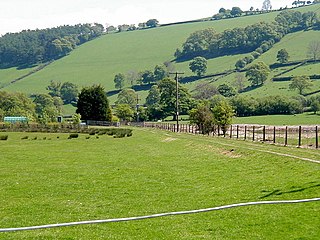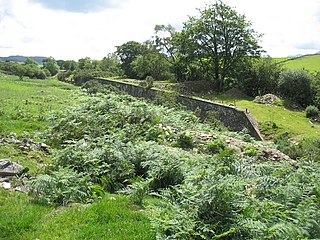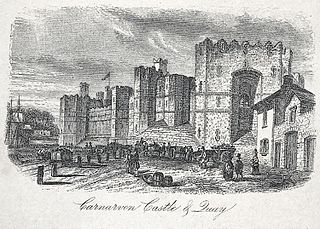
The North Wales Narrow Gauge Railways (NWNGR) was a railway company that planned to build a number of inter-connected 1 ft 11+1⁄2 in narrow-gauge railways across North Wales. The first two of these lines – jointly known as the "Moel Tryfan Undertaking" – were authorised by act of Parliament, the North Wales Narrow Gauge Railways Act 1872 and were built and opened in the 1870s. The original main line ran from Dinas Junction to Bryngwyn and opened in 1877. The second line was a branch from Tryfan Junction to South Snowdon, though shortly after opening, the company designated the Tryfan Junction to Bryngwyn section as the branch, and the Dinas Junction to South Snowdon section as the main line.

Penygroes railway station was located in Penygroes, Gwynedd, Wales.

Bala Junction railway station was on the Ruabon to Barmouth line in southern Gwynedd, Wales. It closed to passengers on Monday 18 January 1965. Bala Junction was unusual in that it was inaccessible by road and merely served as an interchange station; it was located about ¾ mile to the south-east of the town of Bala.
The Denbigh, Ruthin and Corwen Railway was a standard gauge railway line that connected Corwen with Denbigh via Ruthin in North Wales.

Tan-y-Manod railway station was a railway station approximately 1 mile (1.6 km) south of Blaenau Ffestiniog, in Gwynedd, North Wales.
The Mawddwy Railway was a rural line in the Dyfi Valley in mid-Wales that connected Dinas Mawddwy with a junction at Cemmaes Road railway station on the Newtown and Machynlleth Railway section of the Cambrian Railways.

The Vale of Clwyd Railway (VoCR) was a standard-gauge line, which connected the settlements of Rhyl, St Asaph and Denbigh in North Wales. It opened in 1858, at first without a connection to the main line at Rhyl, but this was provided in 1862. At Denbigh, a connection could be made on to the Mold and Denbigh Junction Railway. Although the area became popular with holidaymakers from the 1920s, the line never realised its potential; it closed to passengers in 1955 and completely in 1968.

The Van Railway was a standard gauge railway in mid Wales. The line was built in 1871 to link the highly productive lead mines at Van, near Llanidloes to the main Cambrian line at Caersws. The mines closed in 1920, but the railway remained open until 1940.

The Vale of Towy Railway (VoTR) was a Welsh railway that provided an 11.25 mile-long extension of the Llanelly Railway from Llandeilo to Llandovery. It was incorporated by act of Parliament (UK), the Vale of Towy Railway Act 1854, of 10 July 1854 and opened on 1 April 1858.
The Morda Tramway refers to two industrial railways south of Oswestry, on the border between England and Wales. They connected the coal pits around Morda to transport networks, the first to the Montgomery Canal and the second to the Cambrian Railways at Whitehaven.

The Crickheath Tramway was a 1.5-mile-long, 2 ft 6 in narrow gauge industrial railway connecting the Porth-y-waen lime quarries near Llanymynech to the Crickheath Wharf on the Ellesmere Canal's Llanymynech branch. It opened in the 1820s and closed in 1913.
The Shrewsbury and Welshpool Railway (S&WR) is a standard gauge railway which connects the towns of Shrewsbury and Welshpool. It opened in 1861 and the majority of the railway continues in use.

The Hay Railway was a narrow gauge horse-drawn tramway in the district surrounding Hay-on-Wye in Brecknockshire, Wales. The railway connected Eardisley in Herefordshire, England, with Brecon in Wales. The Brecon terminus was Watton Wharf on the Brecknock and Abergavenny Canal.
The Elan Valley Railway (EVR) was a Welsh industrial railway built to assist in the construction of the Elan Valley Reservoirs in mid Wales. It was in operation from 1896 to about 1912/1916.
The Conway and Llanrwst Railway was a standard gauge railway built to connect the Welsh coastal town of Conway, nowadays addressed by its Welsh name of Conwy, with the inland towns of Llanrwst and Betws y Coed. It opened in 1863 and was eventually absorbed into the lines operated by the London and North Western Railway. In 2008 it continues to operate as part of the Conwy Valley Line.
The Dyserth branch line was a short standard-gauge mineral railway between the northern end of the Clwydian Range at Dyserth and the North Wales Coast Line at Prestatyn. The line was constructed by the London and North Western Railway in 1869; it was built to carry quarried stone and coal. The rise of tourism led to the introduction of a passenger service in 1905. There were stations at Dyserth and Meliden, and basic halts were built at other stopping places. Competition from road transport led to the passenger service being withdrawn in 1930. With the eventual demise of all the mineral industries around Dyserth the entire line was closed in September 1973.
The Bethesda branch line was a 4+1⁄4-mile (6.8 km) railway branch line between Bangor and Bethesda in Gwynedd, North Wales. Its primary purpose was to bring quarried slate down to the main line for onward transport.

Trawsfynydd Camp railway station, sometimes referred to as Trawsfynydd Military station served the Trawsfynydd Artillery range at Bronaber, south of Trawsfynydd in Gwynedd, Wales. The station never opened for civilian traffic.

Carnarvon Castle railway station was opened in 1856 by the narrow gauge Nantlle Railway near the foot of what is today the Allt Y Castell which slopes down to Caernarfon's harbour area. It was the line's northern terminus and was the closest of Caernarfon's ultimately five stations to the historic town centre.

The Merionethshire Railway (MR) was a proposed 1 ft 11+3⁄4 in and 4 ft 8+1⁄2 in dual gauge railway in south Caernarfonshire North Wales, United Kingdom. It was incorporated by an act of Parliament on 29 June 1871. Powers to build the line lapsed in 1885 and were abandoned on 12 July 1887. Work to build the line never started, though parliamentary extensions of time to do so were obtained in 1876, 1879, and 1882.












